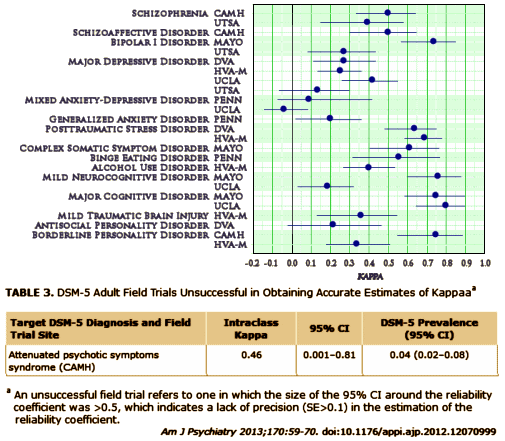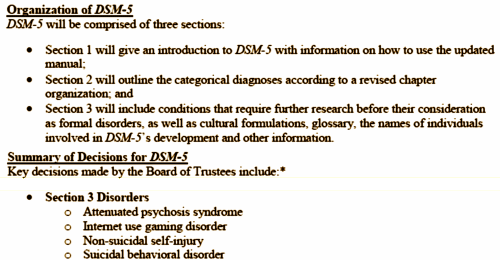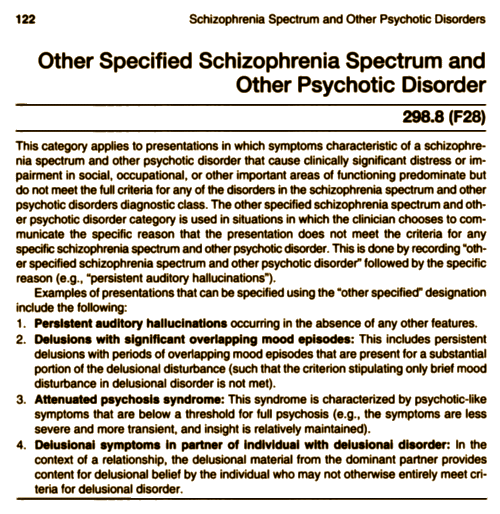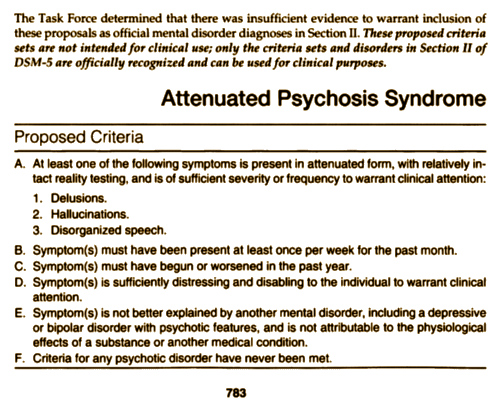Huffington Postby Allen Frances11/26/2013It was at a cocktail party four years ago that I first heard about the plan to include a ‘Psychosis Risk Syndrome’ in DSM-5. The idea was to diagnose and treat subthreshold psychotic symptoms early enough to prevent the later development of full blown psychotic disorders. The motive for introducing ‘Psychosis Risk Syndrome’ was noble, but I knew immediately that the results could be disastrous- misdiagnosis, stigma, and exposure to unnecessary and harmful antipsychotic meds. Most youngsters meeting criteria for Psychosis Risk Syndrome’ would never go on to develop a psychotic disorder. Given this high false-positive rate, the very real risks to the many seemed far to outweigh any theoretical benefits to the few.
Eventually most researchers – even those who had devoted their careers to researching Psychosis Risk Syndrome — came to agree with me that APS was not ready for inclusion in DSM-5. And finally, even DSM-5 saw the light and dropped the proposal to make Psychosis Risk Syndrome an official category with a code of its own for reimbursement. Or so I thought until I received an email from Sarah Kamens, a doctoral student in psychology at Fordham University, who has become an expert on psychiatric diagnosis and one of the most careful readers and thoughtful critics of DSM-5. She wrote:
"The mental health community breathed a big sigh of relief when ‘Psychosis Risk’ [AKA Attenuated Psychosis Syndrome’] was rejected as an official category by DSM-5 and was instead exiled to a section of the manual for research suggestions that are not ready for clinical prime time.""’Psychosis Risk’ had been DSM-5’s most feared and controversial proposal because it doesn’t do a good job of actually predicting psychosis and might well cause stigma and exacerbate the already existing, wildly excessive use of antipsychotic medicine in teen-agers."
"The change was announced on the official DSM-5 website and was covered widely in major news media, including the New York Times."
"But there is an unnoticed and quite disturbing sequel. It turns out that, despite APA assurances, ‘Psychosis Risk’ has sneaked into DSM-5 in an unexpected place. Under its alternate name ‘Attenuated Psychosis Syndrome’ [APS], it is now included in the section on Schizophrenia Spectrum and Other Psychotic Disorders as one type of ‘Other Specified Schizophrenia Spectrum Disorder"/"Other Psychotic Disorder’. And it can be coded for reimbursement purposes as 298.8 [F28]."
"It’s not at all clear by what process APS found this circuitous and disguised route into the main body of DSM-5 and why it was graced in this way with an official code. But it is crystal clear that the mental health world and, more importantly, the general public have been misinformed."
"As an ‘Other’ disorder with its own numerical code, APS can now be diagnosed and used to bill for insurance reimbursement. And those who end up bearing the diagnostic label, many of them young adolescents and adults who will never develop schizophrenia or any other psychotic disorder, will be told that they have an ‘Other Specified Schizophrenia Spectrum Disorder.’"Thanks, Sarah, for picking up this serious DSM-5 error overlooked in my previous catalog of eighteen DSM-5 mistakes.The only way to avoid the perils of DSM-5 is to be fully aware of them. It makes absolutely no sense to pin the misleading and stigmatizing label ‘Other Specified Schizophrenia Spectrum Disorder’ on someone who, in typical settings, will have only about a 10% chance of ever becoming psychotic. And certainly it makes no sense to follow this misdiagnosis with an unproven and potentially very harmful antipsychotic treatment. Preventing psychosis would be a great idea if we could really do it; but there is no reason to think we can. And reaching beyond our grasp is likely to harm those we hoped to help. Psychosis Risk is an important research topic for future investigation, but should never be used now as a clinical diagnosis because it will almost always be wrong. The road to hell is paved with good intentions and bad unintended consequences.
First, Do No Harm.
In December, the APA Trustees met and made a final approval of the DSM-5, saying in their press release:
Now, Sarah Kamens, an astute graduate student points out that that’s not at all what happened when the DSM-5 went to press. So what in the hell did happen? This is where Dr. Frances may be being way too forgiving, too kind. Somehow, against the directive of the DSM-5 Trustees, the Attenuated Psychosis Syndrome made its way into the official manual as an official diagnosis under ‘Other Specified Schizophrenia Spectrum Disorder"/"Other Psychotic Disorder’ anyway. That’s a more exalted place than the one originally proposed – a separate diagnosis! Now it’s part of Schizophrenia proper – even with only a 10% [or less] conversion rate to psychosis. So in spite of the overwhelming negative reaction, the uniform advice of the people who were the experts in the field, the inconclusive Field Trials, and the express decisions of the APA Board of Trustees, the Attenuated Psychosis Syndrome found a place in the official DSM-5 for its lifespan.
That was no accident. No whoops. That’s foulplay, and this almost universally discredited diagnosis is now a Specified Schizophrenia Spectrum Disorder. Given their track record, the APA is unlikely to even investigate how this outright skullduggery happened, but it’s an outrageous piece of work! And it’s further evidence that the expert opinion system of the DSM-5 Task Force was corrupted beyond salvation.
![]()





Boycott it.
http://www.madinamerica.com/2013/12/dsm-5-boycott-enters-2nd-phase-primer-dsm-diagnosis-campaign/
Gee, not only is it Nancy Pelosi and the Democraps who got away with “pass this law and we’ll find out what’s in it”, but the APA cronies who say “just print this manual and we’ll find out what’s in it”!
Another example of what characterological behaviors get away with these days.
But, now there might be a paper trail to implicate the APA WHEN stupid clueless doctors follow this phony lead and cause much harm and mayhem, and then in the discovery process of the eventual lawsuit it is revealed the APA was behind this malpractice agenda.
Gee, there might be a god after all. Don’t let the APA get ahold of him/her and try to medicate the omnipotent being first!!!
Wherever you got the idea that the Democrats don’t know what’s in the ACA, Joel, perhaps you’d like it explained to you by a Republican.
http://www.policymic.com/articles/65079/obamacare-explained-in-7-easy-steps-by-its-original-creator-mitt-romney